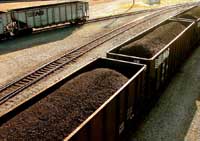Transportation of Fossil Fuels
Despite their negative environmental impacts, fossil fuels are still in high demand. This means they need to be transported around the country--and sometimes—around the world.
Petroleum (Crude Oil)
Natural Gas
Coal



Petroleum (crude oil) is relatively easy to transport, but can cause catastrophic damage if spilled. The safest and cheapest way to transport large amounts of petroleum (crude oil) over land is via pipelines. Construction, placement of the pipeline and control of the pipeline often figure heavily in politics between states and countries. When petroleum (crude oil) needs to travel overseas, oil tankers are used.
Natural gas is easy to transport over land in pipelines, but difficult to transport over oceans due to its low density and thus large volume. Increasingly, countries are importing and exporting natural gas in a liquefied form. If natural gas is chilled to about -260°F, it changes to liquid form and can be easily transported and stored. It takes up much less space and can be loaded into domed tanks, like the ones pictured on the tanker above. The tanks hold the gas in liquefied form until it’s needed, then it is converted back into gas and sent through pipelines to consumers.
Transporting coal can be costly but there are many ways to do it. Most of the coal in the USA travels by train, at least for part of its journey from mine to market. Near the mine, coal can be moved around by trucks and conveyors. River barges and ships are often a cheaper means of transport than trains but are obviously limited in where they can go. Finally, if the coal is crushed and mixed with water, it can even travel through a pipeline!
